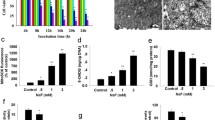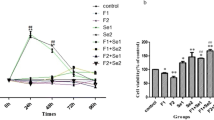Abstract
Increasing evidence has suggested an important role played by reactive oxygen species (ROS) in the pathogenesis of fluorosis. Accumulating evidence demonstrates that vitamin C administration ameliorate sodium fluoride (NaF)-induced oxidative stress. However, the potentially beneficial effects of vitamin C against NaF-induced cytotoxicity and the underlying molecular mechanisms of this protection are not fully understood. Here, we found that NaF stimulated cytotoxicity, increased mitochondrial reactive oxygen species (mROS) production, and induced apoptosis in F9 embryonic carcinoma cells. Consistent with this finding, NaF exposure was associated with decreased Sirtuin 1 (Sirt1) protein expression, thus promoted the acetylation of manganese superoxide dismutase (SOD2), a key enzyme involved in regulating mROS production. However, all NaF-induced mitochondrial oxidative injuries were efficiently ameliorated by overexpression of Sirt1 or incubation with Mito-TEMPO (a SOD2 mimetic). Moreover, pretreatment with vitamin C enhanced the expression of Sirt1 and decreased NaF-induced mitochondrial oxidative stress and apoptosis. Knockdown of Sirt1 blocked the vitamin C-mediated reduction in mROS and apoptosis via inhibiting Sirt1-SOD2 signaling. Importantly, sodium-dependent vitamin C transporter 2 (SVCT-2) siRNA was found to partially block the ability of vitamin C to promote Sirt1/SOD2 signaling. In summary, our data indicate that Sirt1 plays a pivotal role in the ability of vitamin C to stimulate SOD2 activity and attenuate mitochondrial oxidative stress, which partially through vitamin C receptor in NaF-induced F9 cells injury.






Similar content being viewed by others
Abbreviations
- NaF:
-
Sodium fluoride
- ROS:
-
Reactive oxygen species
- mROS:
-
Mitochondrial reactive oxygen species
- Sirt1:
-
Sirtuin 1
- SOD2:
-
Manganese superoxide dismutase
- SVCT-2:
-
Sodium-dependent vitamin C transporter 2
- GLUT1:
-
Glucose transporter 1
- Bax:
-
Bcl2 associated X protein
- Bcl-2:
-
B cell CLL/lymphoma 2
- COX IV:
-
Cytochrome C oxidase subunit IV isoform 1
- GAPDH:
-
Glyceraldehyde-3-phosphate dehydrogenase
- O2•− :
-
Superoxide
- Co-IP:
-
Coimmunoprecipitation pull-down
- MMP:
-
Mitochondrial membrane potential
References
Zuo H, Chen L, Kong M, Yang Y, Lu P, Qiu L, Wang Q, Ma S, Chen K (2018) The toxic effect of sodium fluoride on Spodoptera frugiperda 9 cells and differential protein analysis following NaF treatment of cells. Environ Pollut 236:313–323. https://doi.org/10.1016/j.envpol.2018.01.054
Lin G, Zhao L, Yin F, Lan R, Li L, Zhang X, Zhang H, Yang B (2011) TCF3 inhibits F9 embryonal carcinoma growth by the down-regulation of Oct4. Oncol Rep 26(4):893–899. https://doi.org/10.3892/or.2011.1376
Tian Y, Xiao Y, Wang B, Sun C, Tang K, Sun F (2018) Vitamin E and lycopene reduce coal burning fluorosis-induced spermatogenic cell apoptosis via oxidative stress-mediated JNK and ERK signaling pathways. Biosci Rep 38(4):BSR20171003. https://doi.org/10.1042/BSR20171003
Suzuki M, Bandoski C, Bartlett JD (2015) Fluoride induces oxidative damage and SIRT1/autophagy through ROS-mediated JNK signaling. Free Radic Biol Med 89:369–378. https://doi.org/10.1016/j.freeradbiomed.2015.08.015
Phan V, Schmidt J, Matyash V, Malchow S, Thanisch M, Lorenz C, Diepolder I, Schulz JB, Stenzel W, Roos A, Gess B (2018) Characterization of naive and vitamin C-treated mouse Schwann cell line MSC80: induction of the antioxidative thioredoxin related transmembrane protein 1. J Proteome Res 17:2925–2936. https://doi.org/10.1021/acs.jproteome.8b00022
Zhao E, Amir M, Lin Y, Czaja MJ (2014) Stathmin mediates hepatocyte resistance to death from oxidative stress by down regulating JNK. PLoS One 9(10):e109750. https://doi.org/10.1371/journal.pone.0109750
Savini I, Rossi A, Pierro C, Avigliano L, Catani MV (2008) SVCT1 and SVCT2: key proteins for vitamin C uptake. Amino Acids 34(3):347–355. https://doi.org/10.1007/s00726-007-0555-7
Wohlrab C, Phillips E, Dachs GU (2017) Vitamin C transporters in cancer: current understanding and gaps in knowledge. Front Oncol 7:74. https://doi.org/10.3389/fonc.2017.00074
Nabavi SF, Habtemariam S, Sureda A, Hajizadeh Moghaddam A, Daglia M, Nabavi SM (2013) In vivo protective effects of gallic acid isolated from Peltiphyllum peltatum against sodium fluoride-induced oxidative stress in rat erythrocytes. Arh Hig Rada Toksikol 64(4):553–559. https://doi.org/10.2478/10004-1254-64-2013-2353
Liu Q, Xiao K, Wen L, Dong Y, Xie G, Zhang Z, Bo Z, Jiang L (2014) A fluoride-driven ionic gate based on a 4-aminophenylboronic acid-functionalized asymmetric single nanochannel. ACS Nano 8(12):12292–12299. https://doi.org/10.1021/nn506257c
Fita K, Kaczmarek U (2016) The impact of selected fluoridated toothpastes on dental erosion in profilometric measurement. Adv Clin Exp Med 25(2):327–333. https://doi.org/10.17219/acem/58893
Zhang S, Jiang C, Liu H, Guan Z, Zeng Q, Zhang C, Lei R, Xia T, Gao H, Yang L, Chen Y, Wu X, Zhang X, Cui Y, Yu L, Wang Z, Wang A (2013) Fluoride-elicited developmental testicular toxicity in rats: roles of endoplasmic reticulum stress and inflammatory response. Toxicol Appl Pharmacol 271(2):206–215. https://doi.org/10.1016/j.taap.2013.04.033
Luangmonkong T, Suriguga S, Mutsaers HAM, Groothuis GMM, Olinga P, Boersema M (2018) Targeting oxidative stress for the treatment of liver fibrosis. Rev Physiol Biochem Pharmacol 175:71–102. https://doi.org/10.1007/112_2018_10
Velarde MC, Flynn JM, Day NU, Melov S, Campisi J (2012) Mitochondrial oxidative stress caused by Sod2 deficiency promotes cellular senescence and aging phenotypes in the skin. Aging 4(1):3–12. https://doi.org/10.18632/aging.100423
Song C, Fu B, Zhang J, Zhao J, Yuan M, Peng W, Zhang Y, Wu H (2017) Sodium fluoride induces nephrotoxicity via oxidative stress-regulated mitochondrial SIRT3 signaling pathway. Sci Rep 7(1):672. https://doi.org/10.1038/s41598-017-00796-3
Miao LP, Zhou MY, Zhang XY, Yuan C, Dong XY, Zou XT (2017) Effect of excess dietary fluoride on laying performance and antioxidant capacity of laying hens. Poult Sci 96(7):2200–2205. https://doi.org/10.3382/ps/pex002
Banala RR, Karnati PR (2015) Vitamin a deficiency: an oxidative stress marker in sodium fluoride (NaF) induced oxidative damage in developing rat brain. Int J Dev Neurosci 47(Pt B):298–303. https://doi.org/10.1016/j.ijdevneu.2015.08.010
Song C, Zhao J, Fu B, Li D, Mao T, Peng W, Wu H, Zhang Y (2017) Melatonin-mediated upregulation of Sirt3 attenuates sodium fluoride-induced hepatotoxicity by activating the MT1-PI3K/AKT-PGC-1alpha signaling pathway. Free Radic Biol Med 112:616–630. https://doi.org/10.1016/j.freeradbiomed.2017.09.005
Alhusaini AM, Faddah LM, El Orabi NF, Hasan IH (2018) Role of some natural antioxidants in the modulation of some proteins expressions against sodium fluoride-induced renal injury. Biomed Res Int 2018:5614803–5614809. https://doi.org/10.1155/2018/5614803
Ameeramja J, Panneerselvam L, Govindarajan V, Jeyachandran S, Baskaralingam V, Perumal E (2016) Tamarind seed coat ameliorates fluoride induced cytotoxicity, oxidative stress, mitochondrial dysfunction and apoptosis in A549 cells. J Hazard Mater 301:554–565. https://doi.org/10.1016/j.jhazmat.2015.09.037
Wei W, Li L, Zhang Y, Geriletu, Yang J, Zhang Y, Xing Y (2014) Vitamin C protected human retinal pigmented epithelium from oxidant injury depending on regulating SIRT1. Sci World J 2014:750634. https://doi.org/10.1155/2014/750634
Song SB, Jang SY, Kang HT, Wei B, Jeoun UW, Yoon GS, Hwang ES (2017) Modulation of mitochondrial membrane potential and ROS generation by nicotinamide in a manner independent of SIRT1 and mitophagy. Mol Cell 40(7):503–514. https://doi.org/10.14348/molcells.2017.0081
Xu S, Gao Y, Zhang Q, Wei S, Chen Z, Dai X, Zeng Z, Zhao KS (2016) SIRT1/3 activation by resveratrol attenuates acute kidney injury in a septic rat model. Oxidative Med Cell Longev 2016:7296092. https://doi.org/10.1155/2016/7296092
Pi H, Xu S, Reiter RJ, Guo P, Zhang L, Li Y, Li M, Cao Z, Tian L, Xie J, Zhang R, He M, Lu Y, Liu C, Duan W, Yu Z, Zhou Z (2015) SIRT3-SOD2-mROS-dependent autophagy in cadmium-induced hepatotoxicity and salvage by melatonin. Autophagy 11(7):1037–1051. https://doi.org/10.1080/15548627.2015.1052208
Liu AJ, Li B, Yang M, Liu Y, Liu YL, Su JW (2017) Sirtuin 1 mediates hydrogen sulfide-induced cytoprotection effects in neonatal mouse cardiomyocytes. Chin Med J 130(19):2346–2353. https://doi.org/10.4103/0366-6999.215328
Wang L, Zhang T, Xi Y, Yang C, Sun C, Li D (2016) Sirtuin 1 promotes the proliferation of C2C12 myoblast cells via the myostatin signaling pathway. Mol Med Rep 14(2):1309–1315. https://doi.org/10.3892/mmr.2016.5346
Funding
This work was supported by the National Natural Science Foundation of China (No. 31702205) and Natural Science Basic Research Plan in Shaanxi Province of China (No. 2017JQ3028).
Author information
Authors and Affiliations
Corresponding authors
Ethics declarations
Conflict of Interest
The authors declare that they have no conflicts of interest.
Additional information
Publisher’s Note
Springer Nature remains neutral with regard to jurisdictional claims in published maps and institutional affiliations.
Electronic Supplementary Material
ESM 1
(DOC 329 kb)
Rights and permissions
About this article
Cite this article
Peng, W., Xu, S., Zhang, J. et al. Vitamin C Attenuates Sodium Fluoride-Induced Mitochondrial Oxidative Stress and Apoptosis via Sirt1-SOD2 Pathway in F9 Cells. Biol Trace Elem Res 191, 189–198 (2019). https://doi.org/10.1007/s12011-018-1599-0
Received:
Accepted:
Published:
Issue Date:
DOI: https://doi.org/10.1007/s12011-018-1599-0




